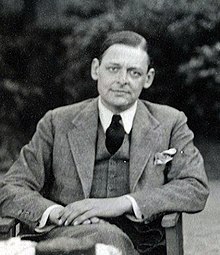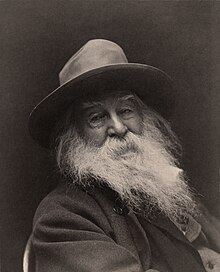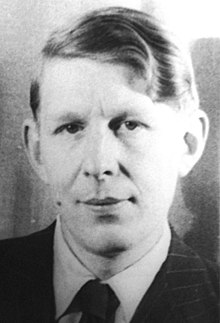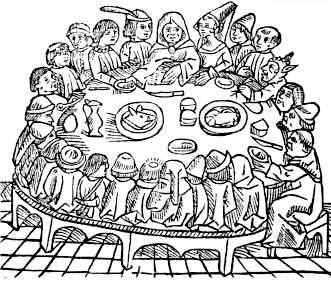 1.Edward Estlin Cummings (October 14, 1894 – September 3, 1962), known as E. E. Cummings, with the abbreviated form of his name often written by others in lowercase letters as e e cummings (in the style of some of his poems—see name and capitalization, below), was an American poet, painter, essayist, author, and playwright. His body of work encompasses approximately 2,900 poems, two autobiographical novels, four plays and several essays, as well as numerous drawings and paintings. He is remembered as an eminent voice of 20th century English literature.
1.Edward Estlin Cummings (October 14, 1894 – September 3, 1962), known as E. E. Cummings, with the abbreviated form of his name often written by others in lowercase letters as e e cummings (in the style of some of his poems—see name and capitalization, below), was an American poet, painter, essayist, author, and playwright. His body of work encompasses approximately 2,900 poems, two autobiographical novels, four plays and several essays, as well as numerous drawings and paintings. He is remembered as an eminent voice of 20th century English literature."somewhere i have never travelled,gladly beyond"
https://www.poets.org/poetsorg/poem/somewhere-i-have-never-travelledgladly-beyond
 2.Thomas Stearns Eliot (26 September 1888 – 4 January 1965), better known by his pen name T. S. Eliot, was an American-born British essayist, publisher, playwright, literary and social critic and "one of the twentieth century's major poets".He moved to England in 1914 at age 25, settling, working and marrying there. He was eventually naturalised as a British subject in 1927 at age 39, renouncing his American citizenship.
2.Thomas Stearns Eliot (26 September 1888 – 4 January 1965), better known by his pen name T. S. Eliot, was an American-born British essayist, publisher, playwright, literary and social critic and "one of the twentieth century's major poets".He moved to England in 1914 at age 25, settling, working and marrying there. He was eventually naturalised as a British subject in 1927 at age 39, renouncing his American citizenship.It was followed by some of the best-known poems in the English language, including 'The Waste Land" (1922), "The Hollow Men" (1925), "Ash Wednesday" (1930) . He is also known for his seven plays, particularly Murder in the Cathedral (1935). He was awarded the Nobel Prize in Literature in 1948, "for his outstanding, pioneer contribution to present-day poetry".
"The Waste Land" is a long poem by T. S. Eliot. It is widely regarded as one of the most important poems of the 20th century and a central text in Modernist poetry. Published in 1922, the 434-line poem first appeared in the United Kingdom in the October issue of The Criterion and in the United States in the November issue of The Dial. It was published in book form in December 1922. Among its famous phrases are "April is the cruellest month", "I will show you fear in a handful of dust", and the mantra in the Sanskrit language "Shantih shantih shantih".
Eliot's poem loosely follows the legend of the Holy Grail and the Fisher King combined with vignettes of contemporary British society. Eliot employs many literary and cultural allusions from the Western canon, Buddhism and the Hindu Upanishads. Because of this, critics and scholars regard the poem as obscure.The poem shifts between voices of satire and prophecy featuring abrupt and unannounced changes of speaker, location, and time and conjuring of a vast and dissonant range of cultures and literatures.
The poem's structure is divided into five sections. The first section, The Burial of the Dead, introduces the diverse themes of disillusionment and despair. The second, A Game of Chess, employs vignettes of several characters—alternating narrations—that address those themes experientially. The Fire Sermon, the third section, offers a philosophical meditation in relation to the imagery of death and views of self-denial in juxtaposition influenced by Augustine of Hippo and eastern religions. After a fourth section that includes a brief lyrical petition, the culminating fifth section, What the Thunder Said, concludes with an image of judgment.
http://www.bartleby.com/201/1.html
3.The Canterbury Tales is a collection of 24 stories that runs to over 17,000 lines written in Middle English by Geoffrey Chaucer. In 1386 Chaucer became Controller of Customs and Justice of Peace and then three years later in 1389 Clerk of the King's work. It was during these years that Chaucer began working on his most famous text, The tales (mostly written in verse, although some are in prose) are presented as part of a story-telling contest by a group of pilgrims as they travel together on a journey from London to Canterbury in order to visit the shrine of Saint Thomas Becket at Canterbury Cathedral. The prize for this contest is a free meal at the Tabard Inn at Southwark on their return.
The Canterbury Tales is near-unanimously seen as Chaucer's magnum opus. He uses the tales and the descriptions of its characters to paint an ironic and critical portrait of English society at the time, and particularly of the Church. Chaucer's use of such a wide range of classes and types of people was without precedent in English. Although the characters are fictional, they still offer a variety of insights into the customs and practices of the time. Often, such insight leads to a variety of discussions and disagreements among people in the 14th century. For example, although various social classes are represented in these stories and all of the pilgrims are on a spiritual quest, it is apparent that they are more concerned with worldly things than spiritual.
4.The General Prologue is the first part of Chaucer's The Canterbury Tales.The frame story of the poem, as set out in the 858 lines of Middle English which make up the general prologue, is of a religious pilgrimage. The narrator, Geoffrey Chaucer, is in The Tabard Inn in Southwark, where he meets a group of "sundry folk" who are all on the way to Canterbury, the site of the shrine of Saint Thomas Becket.
The setting is April, and the prologue starts by singing the praises of that month whose rains and warm western wind restore life and fertility to the earth and its inhabitants. This abundance of life, the narrator says, prompts people to go on pilgrimages; in England, the goal of such pilgrimages is the shrine of Thomas Becket. The narrator falls in with a group of pilgrims, and the largest part of the prologue is taken up by a description of them
 5.Walter "Walt" Whitman ( May 31, 1819 – March 26, 1892) was an American poet, essayist and journalist. A humanist, he was a part of the transition between transcendentalism and realism, incorporating both views in his works. Whitman is among the most influential poets in the American canon, often called the father of free verse.His work was very controversial in its time, particularly his poetry collection" Leaves of Grass", which was described as obscene for its overt sexuality.
5.Walter "Walt" Whitman ( May 31, 1819 – March 26, 1892) was an American poet, essayist and journalist. A humanist, he was a part of the transition between transcendentalism and realism, incorporating both views in his works. Whitman is among the most influential poets in the American canon, often called the father of free verse.His work was very controversial in its time, particularly his poetry collection" Leaves of Grass", which was described as obscene for its overt sexuality.Born in Huntington on Long Island, Whitman worked as a journalist, a teacher, a government clerk, and—in addition to publishing his poetry—was a volunteer nurse during the American Civil War. Whitman's sexuality is often discussed alongside his poetry. Though biographers continue to debate his sexuality, he is usually described as either homosexual or bisexual in his feelings and attractions. However, there is disagreement among biographers as to whether Whitman had actual sexual experiences with men.
When Lilacs Last in the Dooryard Bloom’d
http://www.poetryfoundation.org/poems-and-poets/poems/detail/45480
6.William Butler Yeats (13 June 1865 – 28 January 1939) was an Irish poet and one of the foremost figures of 20th-century literature. A pillar of both the Irish and British literary establishments, in his later years he served as an Irish Senator for two terms. Yeats was a driving force behind the Irish Literary Revival and, along with Lady Gregory, Edward Martyn, and others, founded the Abbey Theatre, where he served as its chief during its early years. In 1923, he was awarded the Nobel Prize in Literature as the first Irishman so honoured for what the Nobel Committee described as "inspired poetry, which in a highly artistic form gives expression to the spirit of a whole nation".
Yeats is generally considered one of the twentieth century's key English language poets. He was a Symbolist poet, in that he used allusive imagery and symbolic structures throughout his career. Yeats chose words and assembled them so that, in addition to a particular meaning, they suggest other abstract thoughts that may seem more significant and resonant. His use of symbols is usually something physical that is both itself and a suggestion of other, perhaps immaterial, timeless qualities.
The Lake Isle of Innisfree
http://www.poetryfoundation.org/poems-and-poets/poems/detail/43281
 7.William Wordsworth (7 April 1770 – 23 April 1850) was a major English Romantic poet who, with Samuel Taylor Coleridge, helped to launch the Romantic Age in English literature with their joint publication Lyrical Ballads (1798).
7.William Wordsworth (7 April 1770 – 23 April 1850) was a major English Romantic poet who, with Samuel Taylor Coleridge, helped to launch the Romantic Age in English literature with their joint publication Lyrical Ballads (1798).Wordsworth's magnum opus is generally considered to be The Prelude, a semiautobiographical poem of his early years that he revised and expanded a number of times. It was posthumously titled and published, before which it was generally known as "the poem to Coleridge".[1] Wordsworth was Britain's Poet Laureate from 1843 until his death in 1850.
I Wandered Lonely as a Cloud
http://www.poetryfoundation.org/poems-and-poets/poems/detail/45521
 8.Wystan Hugh Auden (21 February 1907 – 29 September 1973) was an Anglo-American poet, best known for love poems such as "Funeral Blues," Auden's poetry was noted for its stylistic and technical achievement, its engagement with politics, morals, love, and religion, and its variety in tone, form and content.He came to wide public attention at the age of twenty-three, in 1930, with his first book, Poems, followed in 1932 by The Orators.He won the Pulitzer Prize in Poetry for his 1947 long poem The Age of Anxiety, the title of which became a popular phrase describing the modern era.In 1956–61 he was Professor of Poetry at Oxford; his lectures were popular with students and faculty and served as the basis of his 1962 prose collection The Dyer's Hand.
8.Wystan Hugh Auden (21 February 1907 – 29 September 1973) was an Anglo-American poet, best known for love poems such as "Funeral Blues," Auden's poetry was noted for its stylistic and technical achievement, its engagement with politics, morals, love, and religion, and its variety in tone, form and content.He came to wide public attention at the age of twenty-three, in 1930, with his first book, Poems, followed in 1932 by The Orators.He won the Pulitzer Prize in Poetry for his 1947 long poem The Age of Anxiety, the title of which became a popular phrase describing the modern era.In 1956–61 he was Professor of Poetry at Oxford; his lectures were popular with students and faculty and served as the basis of his 1962 prose collection The Dyer's Hand.Auden was a prolific writer of prose essays and reviews on literary, political, psychological and religious subjects, and he worked at various times on documentary films, poetic plays, and other forms of performance. Throughout his career he was both controversial and influential, and critical views on his work ranged from sharply dismissive, treating him as a lesser follower of W. B. Yeats and T. S. Eliot, to strongly affirmative, as in Joseph Brodsky's claim that he had "the greatest mind of the twentieth century".
Stop all the clocks, cut off the telephone http://homepages.wmich.edu/~cooneys/poems/auden.stop.html
Vocabulary
1.ann, enn- roots means "every years"
For Example- perennial, anniversary, annuity
2.sol- prefix means"lonely"
For Example- solitud
Video
https://www.youtube.com/watch?v=DDXWclpGhcg



沒有留言:
張貼留言